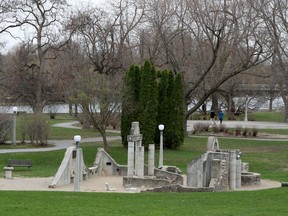Officials say risk to the public is low at most of the sites, including Strathcona Park in Sandy Hill.

A number of locations in Ottawa and its surrounding area are being assessed for unexploded munitions and related debris from past wars, the Department of National Defence has confirmed.
But department officials believe the danger to the public is low at most of the sites, which include Strathcona Park in Sandy Hill.
In 2006, DND started raising concerns that the risk of the public encountering unexploded bombs or UXOs from the Second World War was increasing due to urban expansion. Several hundred UXO legacy sites are known to exist on land at locations across the country. In addition, 1,100 sites are in the ocean on Canada’s east coast, with 26 more on the west coast.
There are at least eight sites in Ottawa “in assessment” according to a DND database of UXO sites.
DND spokesperson Kened Sadiku says 551 sites are currently being assessed across Canada and risk mitigation measures have been put in place at 22 locations.
One Ottawa-area site that DND put on-going safety measures in place for involves the Ottawa River, near Petawawa. Some artillery rounds fired from the Garrison Petawawa training area over the decades have landed in the water or on beaches.
Sadiku says that risk “continues to be mitigated by restricting access to the shoreline beaches along the Ottawa River and the Garrison, including Wegner Point, Antler Point, Gust Point and Kiska Beach.”
He also pointed out in an emailed statement that other measures to deal with suspected UXOs along the Ottawa River included signage explicitly warning of the presence of unexploded munitions. “In addition, white buoys are located along the shoreline of the Garrison Petawawa Training Area to indicate danger, and on a portion of the shoreline there are also yellow buoys which indicate restricted areas,” he added.
But in many cases sites remain “in assessment” for some time — this is usually because they are not considered priority locations, Sadiku explained. “The great majority of UXO legacy sites do not end up presenting an elevated UXO risk but, out of an abundance of caution, all sites will eventually be formally assessed for UXO risk,” he added.
Other sites still being assessed include a former bombing range near Winchester, DND property at Uplands and Haycock Island in Shirley’s Bay in the Ottawa River. Other assessments in the area include a former air force south of Carp.
But military experts believe the 500-pound and 1,000-pound bombs pose a low risk as long as they remain undisturbed by the public, the records point out.
It has been previously known in some military circles that UXOs were believed to be still in the bog, which during the Second World War was a Royal Canadian Air Force bombing range. The records, obtained through an access-to-information request, provided more details than previously made public about the popular hiking and conservation area in the greenbelt.

“During the site’s active years 500 to 1,000 pound bombs were dropped on the site using the small islands in the center [sic] of the bog as targets,” outlined a March 26, 2004 letter from Susan Home, a realty research officer for Director of Realty Assets and Plans at the Department of National Defence (DND). “It is believed that there are many unexploded bombs sunk in the mud of the bog.”
Another DND report from 1973 concluded: “A large number of high explosive bombs were dropped on this range which failed to function. The number and location of these unexploded ordnance could not be determined.”
Paul Ozorak, who compiled the original list of UXO sites for DND more than 20 years ago, said in theory there could be hundreds of thousands of unexploded pieces of ordnance scattered across the country. During the Second World War, the Canadian military had large numbers of bases and facilities, he added.
“One air force training school from the war could have as many as five different practice bombing ranges,” said Ozorak, the author of four books on abandoned military installations in Canada.
In other cases, chemicals would have been stored at the various locations. Ozorak noted, for instance, that mustard gas was stored in Cornwall, Ont. Other chemical weapons were dumped in the oceans after the conflict ended.
The DND reports obtained by the Ottawa Citizen noted there have been a small number of deaths over the years from the bombs exploding at locations across the country but the documents didn’t contain specific details.